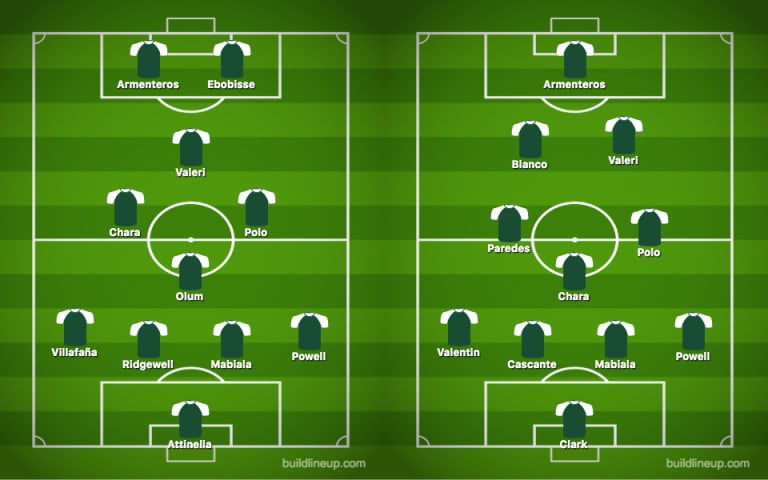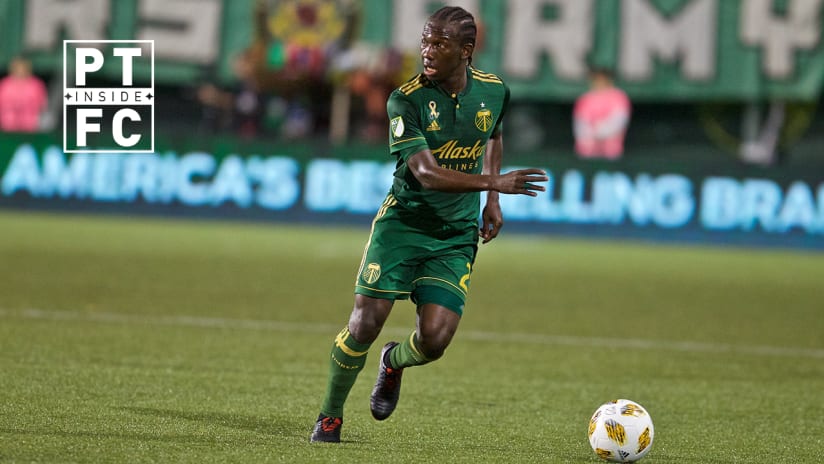PORTLAND, Ore. – Diego Chara’s reputation is built on being a destroyer, a ballhawk – a No. 6 whose tenacity in the tackle and explosion on the counter attack, together, may be unparalleled in Major League Soccer. But along the path of the Portland Timbers’ 2018 season, Chara’s responsibilities are starting to morph. Suddenly, the Colombian midfielder is playing as much time in higher up the field, in a No. 8’s role, than in the team’s deepest midfield spot.
“The position I’m in right now, it’s a little different,” Chara said, two weeks ago, “but I believe the things I’m being asked to do are the same on the field: try to win the ball back; try to maintain a balance between defense and attack. But I think in my new position I have a little more freedom to get into the attack. I think that is the main difference this year.”
We should backtrack here, slightly, and explain what this position change really entails. Often, in this space, we get so caught up in the game’s jargon that we forget: No. 6 and No. 8 are foreign terms, to some. To others, the distinction might not be clear. Either way, it’s good to define our terms before leaping forward.
“No. 6” is the designation that’s traditionally given to the team’s deepest midfielder, somebody who, defensively, acts disruptor to the other team’s attack and a shield for their own backline. In attack, the No. 6 – sometimes referred to as a defensive midfielder or, depending on a team’s scheme, holding midfielder – is vital when possession is built from the back, play is moved from side to side, or players further up the field need an outlet from pressure.

In front of that sitting midfielder, teams often deploy No. 8s, players often called “box-to-box” players because of responsibilities that span a greater length of the field. They, as Chara said, “have a little more freedom to get into the attack,” as well as a responsibility to do so. When oppositions are handling a team’s true attack-first options (forwards, wingers, attacking midfielders), it’s the next level of midfielders that must get forward and help improve their team’s odds.
Through Chara’s 24 MLS starts in 2018, we’ve gotten a near split of his time between the team’s deepest midfield role (13 starts) and his time higher up the field (11). During those games, the Timbers have a slightly better record when he’s deeper on the field but a better goal difference, on a per-game basis, when Chara’s playing as an eight.
Diego Chara's Position |
GP |
Record |
GF |
GA |
|---|---|---|---|---|
Deepest midfielder |
13 |
7-2-4 |
22 |
17 |
Higher/central midfielder |
11 |
6-3-2 |
18 |
13 |
Thirteen and 11 game samples wouldn’t be enough to draw conclusions about positions where we have hard data on individual performances, like striker, let alone something more nebulous like a midfielder’s contributions, but both numbers could fuel a biased arsonists’ flames. If you’re inclined to look at Chara’s history of success in Portland and note where he’s usually been on the field, it’s easy to claim that he should stay as the team’s deepest midfielder. But if you take inventory of Chara’s skills, note his mobility and ability to contribute building play going forward, it’s just as easy to make a case that he should be playing higher up the field.
Giovanni Savarese may be making that case, now. On this weekend’s FOX 12 PLUS broadcast, Timbers analyst Ross Smith relayed as much. From Smith’s recollection of a conversation he had with Savarese before the game, the Timbers boss said his decision to switch Chara out of the No. 6 spot, where he was originally working last week, to a No. 8’s role was about getting the player’s attacking contributions further up the field. Why, the view implicitly asks, would you limit Chara’s influence by restricting him to a deeper role?
Perhaps that’s a reflection of the roster’s current state, one that continues searching for the best way to build play in this post-Darlington Nagbe world. But it is also the reflection of Portland’s reality closer to goal, one where the team only has three established goalscorers right now. In a world where only Samuel Armenteros, Sebastián Blanco and Diego Valeri are producing goals, getting Chara’s skills and intelligence higher up the field may be important than ever before – particularly in situations like Saturday’s, where Blanco was unavailable due to yellow card accumulation.
There was no better example of this than Aug. 29’s game against Toronto. The Timbers went into the match scoreless in their previous five halves of soccer but had been working for some time on a combination that would create chances for a central midfielder trailing play on driven crosses from Blanco. In that match, Chara – who had previously been playing on the right of a midfield three – was flipped to the left, the side of play Portland was increasingly favoring when forced to build play from the back.
Against Toronto, though, a quick chance created through the right produced this, Chara’s only goal of the season:
“All we want to do is score goals,” Chara said, in Spanish, when asked whether he prefers the added attacking responsibilities. “But yes, I do quite like playing this role, because in this position, I have a little more freedom, and I’m going to have more options. That gives us a chance to do a little more (going forward).”
That won’t always be the case, though, and as Saturday’s game showed, there are still significant defense responsibilities that go into Chara’s No. 8 role. Against FC Dallas, Portland often tried to push play to one side of the field, Chara’s side. There, the team tried to trap Dallas against the sideline and force play from coming back to the middle of the park. That, in theory, is where the Timbers’ guests would have to make their toughest decisions.
It’s not an uncommon tactic – often teams try to force play to one side and keep it from coming back – but the fact that Portland was so often steering play toward Chara was telling. The scheme meant that Chara’s central, left-sided midfield role may have been the most important defensive player; at least, it was the most important in midfield. It also meant that, despite playing slightly higher up the field, the defending required from Diego Chara, Portland Timbers No. 8, was not entirely different than the defending, ball-winning, overall deterrence we’d see from Diego Chara, Portland Timbers’ No. 6.
Consider this moment from Saturday’s second half. It was perhaps the funniest of the night of Chara harassing Dallas right back Reggie Cannon, but it also indicative of Portland’s overall plan.
Also consider this moment, from early in the first half, showing what the team’s overall plan had the potential to do on the counterattack, were it executed better …
… as well as this, from the second half, showing what Chara’s instincts and execution are capable of providing when he’s played higher on the field. This might have been Portland’s best chance of taking full points on Saturday.
“I think that positions are just numbers on a board,” Chara says, “and from there it’s up to the player how they play that position.” Seeing Chara split time between his two roles, this season, we know he’s the same player in both.
“As soon as I play in location, and we start playing and the game develops, we take up different places. So, I think these positions are only a starting point. You go back to your principles, how you’ve prepared, and you have liberty from there to play.”
That liberty is being used more liberally, this season. And in time, Chara may prove to be vastly better in one role than the other. But in games like Saturday’s, when there is a specific job to be done higher up the field, you can see why Chara’s skillset makes sense in the No. 8’s role. And at other times, such as when Blanco is both available and playing deeper, it makes sense to cast Chara in the role that’s won him his MLS renown.












